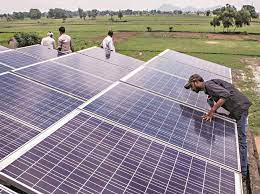An energy conundrum : On India betting big on solar power
Solar power is important for India, but it will not serve every energy need
At the core of India’s energy transformation is its bet on solar power. Based on a commitment to address the global climate crisis, India has promised to source nearly half its energy from non-fossil fuel sources by 2030 and, in the shorter term, source at least 60% of its renewable energy from solar power. However, a disclosure in Parliament by the Minister for Power, New and Renewable Energy suggests that India faces significant headwind in this quest. A key central policy to source solar power is facilitating the establishment of large solar parks; small solar power projects usually translate to higher per-unit production costs. And so, in 2014, the Centre announced the ‘Solar Parks and Ultra-Mega Solar Power Projects’ policy to facilitate the creation of large parks. The initial plan was to set up 25 parks capable of generating at least 20,000 MW by 2019. In 2017, the Government scaled this to 61 parks with a target of 40,000 MW. It emerges, however, as of 2022, that only a fourth of the capacity has been achieved, that is, projects worth 10,000 MW have been commissioned. Four projects have been cancelled, by the Centre’s own admission, due to tardy progress. The roadblocks, in the Centre’s estimate, have been challenges in acquiring land with a clear title, setting up infrastructure necessary to transmit power produced at these parks to the grid and, in an unusual disclosure, “environmental issues” in Rajasthan and Gujarat, where projects have been halted because their transmission lines encroach upon the habitat of the critically endangered Great Indian Bustard.
Notwithstanding its claims on international podia that it is on track to meeting renewable energy targets, it is no secret that India is lagging behind. By the end of 2022, India had committed to having in place 1,75,000 MW of renewable energy capacity, with 1,00,000 MW from solar power. However, only around 61,000 MW of such capacity has actually been installed. For a few years now, there has been considerable hype around solar power achieving grid parity in India — meaning power companies are able to sell it at a price lower or as much as conventional sources — but this does not account for the subsidies or concessions front-loaded by the Government. While India should continue to expand its economy on the back of renewable energy, the Government must take a hard look at whether renewable power, solar, wind or nuclear, meets standards of economic viability and environmental sustainability. Solar power may be a valuable tool in India’s energy transformation story, but it cannot be the panacea for every need.
